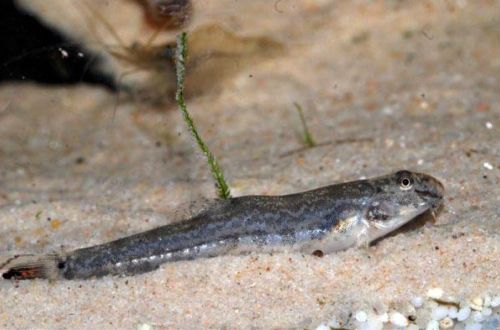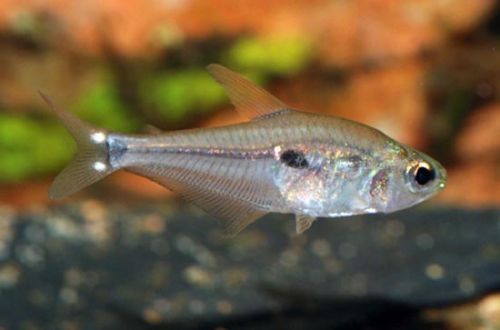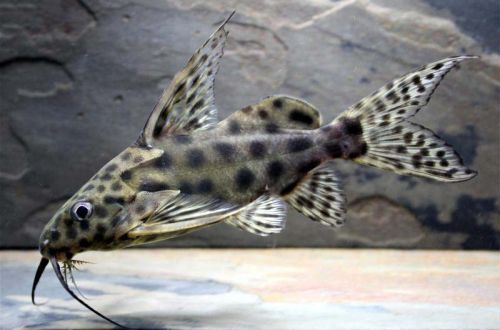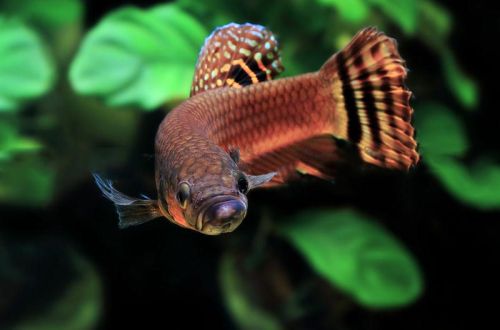
Vyun-Peacock
Peacock Loach or Annandale Loach, scientific name Lepidocephalichthys annandalei, belongs to the family Cobitidae (Loaches or Loaches). The fish is named after the former director of the Zoological Survey of India, Dr. N. Annandale. Another name is associated with the features of the pattern on the tail, more on that below. The fish is unpretentious and hardy, able to endure quite strong changes in the external environment that would have a detrimental effect on other fish. Due to its high adaptability, ease of maintenance and peaceful disposition, it can be recommended to beginner aquarists.

Contents
Habitat
The fish is native to South Asia. Inhabits the middle and upper reaches of the Ganges and Brahmaputra rivers up to their confluence. Thus, the natural habitat extends to the territory of India, Nepal and Bangladesh.
Occurs in shallow, slowly moving sections of streams, swamps, backwaters, rice fields. The substrates consist of a thick layer of soft silt, sand mixed with fallen leaves and branches. During dry periods, some of the reservoirs become shallow and the fish spend a long time in semi-liquid mud.
Brief information:
- The volume of the aquarium – from 40 liters.
- Temperature – 22-26°C
- Value pH — 5.5–7.5
- Water hardness – soft to medium hard (2-15 dGH)
- Substrate type – soft sandy
- Lighting – subdued or moderate
- Brackish water – no
- Water movement is weak
- The size of the fish is about 4 cm.
- Nutrition – any drowning
- Temperament – peaceful
- Keeping in a group of 3-4 individuals
Description
Adults reach a length of about 4 cm. The fish has an elongated body and a small head. At the mouth are antennae, helping to search for food in a layer of silt. The fins are short and translucent. The pectoral ones have a horizontal orientation and are designed more for leaning on the ground than for swimming. The back and sides are covered with a gray-brown pattern. The belly is plain white. A characteristic feature of the species is the variegated coloring of the tail with a large black spot against a background of orange hues, vaguely resembling a feather from a peacock’s tail.
Food
In nature, it feeds by sifting pieces of silt in search of organisms inhabiting it (insect larvae, crustaceans, etc.). In a home aquarium, it will accept most popular foods of a suitable size. Frozen or live foods such as daphnia, brine shrimp, bloodworms, etc. are good choices.
Maintenance and care, arrangement of the aquarium
The optimal size of the aquarium for a group of 4 fish starts from 40 liters. In the design of key importance is the ground. As noted above, the peacock Loach feeds in the bottom layer, filtering a portion of the substrate, so the soil should consist of fine sand or similar materials. Additional decorative elements will be a variety of snags that can act as shelters. It is advisable to install subdued lighting. When choosing live plants, species that form dense “carpets” on the bottom (may interfere with feeding) and with a weak root system (may be pulled out) should be avoided. Preference should be given to shade-loving species that can grow out of the ground on hard surfaces (stone, driftwood).
Keeping an Annandale charr will not cause any difficulties even for a beginner in the aquarium trade. The fish is very hardy and perfectly adapts to a variety of conditions. If other species successfully live in the aquarium, then the peacock loach will also feel good.
Behavior and Compatibility
Peaceful, calmly relates to representatives of other species of comparable size and temperament. Prefers to be in a group, it is recommended to purchase from 4 individuals. The presence of neighbors in the aquarium is even mandatory to a certain extent. In the wild, this type of charr is guided by fish swimming from above in order to learn in advance about the appearance of predators. If no one is swimming above, this is a danger signal.
Fish diseases
The main cause of disease in aquarium fish is being in unsuitable conditions that negatively affect the immune system and make them prone to various infections. When the first symptoms appear, it is worth first checking the hydrochemical composition of the water for compliance with the pH and dGH values, the presence of excess concentrations of nitrogen cycle products or the presence of impurities. Bringing all values back to normal often leads to recovery. If the symptoms persist, you will have to start medical treatment, more in the section “Diseases of aquarium fish”.





